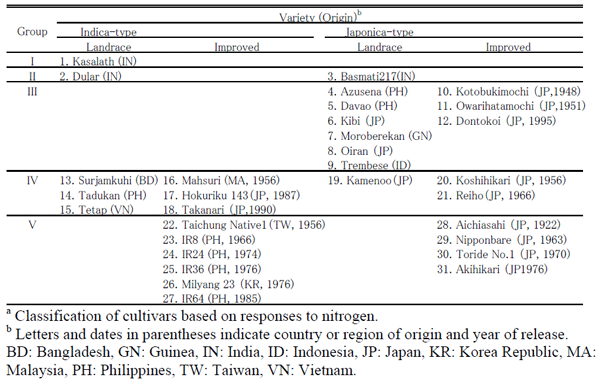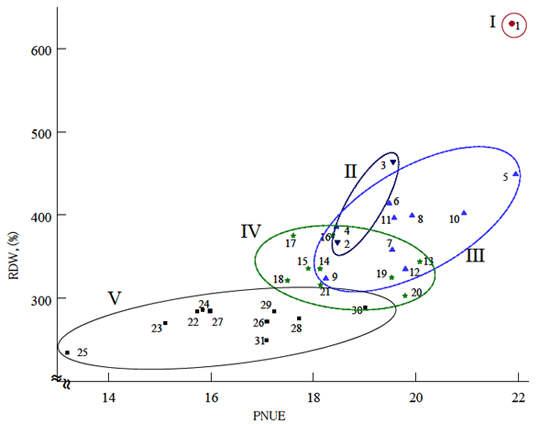Reaction of landraces to nitrogen was more sensitive than those of improved varieties at early vegetative growth stage
Description
The objective of this study was to investigate varietal differences in dry matter production and physiological nitrogen use efficiency (PNUE) using a wide range of rice (Oryza sativa L.) varieties at an early growth stage. The results provided useful information for breeding suitable varieties under conditions of low soil fertility or with reduced fertilizer use for sustainable agriculture. No previous studies of varietal differences in nitrogen response have accounted for the factors of agro-ecotype, geographic adaptation, and degree of improvement. Furthermore, although it is necessary to establish control for the effects of embryo and/or endosperm size on initial growth in order to investigate varietal differences at early growth stages, most studies of varietal differences in nitrogen response have not considered these effects.
We selected 31 varieties based on 3 criteria: agro-ecotype (Indica- or Japonica-type), adaptation to lowland or upland, and degree of improvement (from landrace to modern variety). Furthermore, we used the relative dry weight (RDW, %) of plants treated with nitrogen in comparison to nitrogen-free controls to investigate for differences in growth resulting from seed attributes.
The seedlings of rice varieties were grown under eight (8) nitrogen treatment conditions. The effects of natural variations in embryo and/or endosperm size on initial growth were controlled by comparing the relative dry weight (RDW) of nitrogen-treated samples and controls.
These varieties were classified into five groups, I to V, through cluster analysis of RDW under different nitrogen concentration conditions. A Indian-type landrace variety Kasalath (comprising cluster I) was seen to be the most sensitive to nitrogen as indicated by both RDW and PNUE, and the improved varieties in cluster V were the most insensitive to nitrogen. Clusters II, III, and IV were intermediate between clusters I and V. Cluster III included mainly upland varieties and differed from cluster IV in PNUE values.
The results suggest that variations may originate from the degree of improvement, from among landraces to recent varieties developed by cross-breeding, and adaptations to irrigated lowland or upland soil conditions.
The landrace, Kasalath, showed good performance with its reaction to nitrogen; it might grow well under low fertilizer condition and can be used for the development of high dry matter rice production.
The responses of these rice varieties to different nitrogen sources, ammonium and nitrate, should be confirmed, and the effect and influence of the nitrogen responses will have to be investigated at the next stage of rice growth, such as the reproductive stage.
Figure, table
-
Table 1. Varieties used in the nitrogen response experiments and their classifications
-
Fig. 1. Relationship between PNUE and RDW for all varieties at 20 mg N L−1 treatment
PNUE: Physiological nitrogen use efficiency of dry matter production per 1 mg absorbed nitrogen. PNUE = Dry matter weight of the leaves and stems (DW, mg) of N treatment—DW of non-N control/
- Affiliation
-
Japan International Research Center for Agricultural Sciences Animal Production and Grassland Division
Japan International Research Center for Agricultural Sciences Biological Resources Division
Japan International Research Center for Agricultural Sciences Crop Production and Environment Division
- Classification
-
Research B
- Term of research
-
FY2009(FY2006~2010)
- Responsible researcher
-
SENOH-NAMAI Sachiko ( Crop Production and Environment Division )
TORIYAMA Kazunobu ( Animal Production and Grassland Division )
FUKUTA Yoshimichi ( Biological Resources Division )
- ほか
- Publication, etc.
-
Namai et al. (2009) Breeding Science 59:269-276.
- Japanese PDF
-
2009_seikajouhou_A4_ja_Part7.pdf194.67 KB


